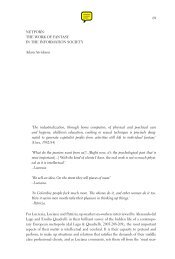Nakamura, Digitizing Race, Introduction, chapter 5, Epilogue
Nakamura, Digitizing Race, Introduction, chapter 5, Epilogue
Nakamura, Digitizing Race, Introduction, chapter 5, Epilogue
Create successful ePaper yourself
Turn your PDF publications into a flip-book with our unique Google optimized e-Paper software.
168 Avatars and the Visual Culture of Reproduction<br />
transmit as any other type of digital file. However, their claims to truth are<br />
compromised partly for this reason; images that exist as a digital signal are<br />
easy to modify in ways that may cast them into doubt as signifiers of things<br />
that “really happened.” Hence digital photography has a different kind of<br />
power in relation to the management of memory, especially in relation to<br />
the domestic and familial sphere.<br />
Much has been written about the particular changes wrought on photographic<br />
practice and theory by digital imaging technology. In The Reconfigured<br />
Eye, William Mitchell notes the ways in which analog images are enduring,<br />
stable, or finished in the ways that digital ones are not, and observes that<br />
“notions of individual authorial responsibility for image content, authorial<br />
determination of meaning, and authorial prestige are correspondingly diminished.”<br />
61 Thus, unlike analog photography, which had a privileged status in<br />
relation to memory, all digital photographs call the idea of truth and authorship<br />
into question. I would contend, however, that both the photograph of<br />
“Little Livy” and the Abu Ghraib photographs are resistant to this dilution<br />
of truth value inherent in the digital. These images are, like the funeral<br />
photography displayed in Lesy and Van Schaick’s book, intensely and purposefully<br />
posed; like them, they are not “snapshots,” and they perform a ritual<br />
function of public mourning in the first instance and militarized racialization<br />
in the second. It was noteworthy that when the Abu Ghraib photographs<br />
were released, nobody thought to question their authenticity despite<br />
their obvious status as digital images; they possessed a cultural truth that<br />
exceeded their always already questionable means of production. Likewise,<br />
the image of “Little Livy” is very much meant to be a “real” versus a fictional<br />
image; unlike the pregnant avatar cartoons and fairylike images of miscarried<br />
“angels” and “vanishing twins” memorialized in Holly’s signature,<br />
Olivia’s is decidedly meant to invoke the sense of “something brought before<br />
the lens,” as Sontag puts it.<br />
The achievement of authenticity in these cases of bodies in pain and<br />
mourning transcends the ordinary logic of the analog versus the digital<br />
photograph because these bodily images invoke the “semimagical act” of<br />
remembering types of suffering that are inarticulate, private, hidden within<br />
domestic or militarized spaces that exclude the public gaze. The truth of<br />
these images remains unquestioned because the notion that someone might<br />
purposely falsify them seems incomprehensible. Women’s digital signatures<br />
on babydream.com perform the important work of visualizing previously<br />
hidden body narratives, and most importantly they do so in a way that juxtaposes<br />
an amazingly broad set of signifiers in the same space: images of happy





